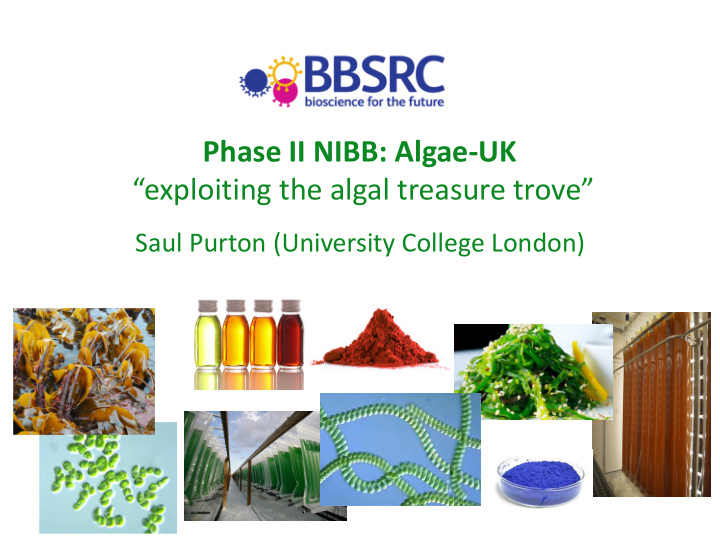



Phase II NIBB: Algae-UK “exploiting the algal treasure trove” Saul Purton (University College London)
The 13 BBSRC phase I NIBB (2014-2019) • Networks comprise members from academia, industry, policy makers & other stakeholders. • Aim to promote and support R&D in industrial biotechnology within the UK. • To raise the profile of IB in UK and abroad. • To build critical mass of expertise, effort and focus. • To attract national and international funding.
Why algae? • Aquatic, solar-powered cell factories • Huge biological diversity (rich resource of novel bioactives, pigments, polymers, oils, etc.) • Largely untapped and unexploited • Wealth of academic expertise in the UK • Lots of industry interest in this emerging ‘blue-green economy’ and opportunities being actively embraced by other countries • But still a fledgling sector, particularly in the UK
The focus of PHYCONET High-value products from microalgae (including cyanobacteria), industrially cultivated in an intensive and controlled manner using photobioreactor technologies.
~750 members The success of PHYCONET ~1,100 followers website 17 PoC and 16 business Seeding interaction Catalyst vouchers awards Outreach 20 training and and educational conference activities awards Overseas 13 monthly newsletter missions to conferences USA, NZ and and China workshops Sponsorship 12 summer of 12 studentships meetings PHYCONET has created a thriving microalgal community in the UK
Algae-UK Patricia Harvey Anna Amtmann Michele Stanley (U. of Greenwich) (U. of Glasgow) (SAMS) microalgae cyanobacteria macroalgae
Algae-UK Key areas of focus are: • Microalgae for pharmaceuticals, nutraceuticals, pigments, food, feed, bio-remediation and bio-recovery • Macroalgae (bioactives, polymers, food & feed additives, AD) - Selective breeding programmes - Genetic engineering/synthetic biology - Advances in intensive cultivation and DSP • Cyanobacteria as light-driven chassis for novel products • Increased focus on supporting ECR, and inspiring & training next generation of algal biotechnologies (e.g. development of experimental kits for schools) • Increased international engagement
Algae-UK activities • Conferences, workshops, training courses, etc. • Support for training, conference attendance, industry secondments • Summer studentships • Sponsorship and partnering of algae-related events • Support for guideline resources: regulations, standards, market potential, etc. • Public outreach activities • Proof-of-concept funding • Overseas missions and international engagement • Establishment of a UK MOOC in algal biotechnology • School projects, kits, STEM engagement
The Algal Innovation Centre, Cambridge A GM-compliant test facility
Algae as food
Chlorella Euglena
Aquaculture feed
Other feed markets Poultry Cattle Ornamental fish
Nutraceuticals
Fucoxanthin – a slimming aid ?
As anti-oxidants or pigments in cosmetics
algal polymers Flip-flops from microalgal polymers Seaweed-based water pouches Prof Steve Mayfield Director: California Center for Algae Biotechnology, UCSD
Recommend
More recommend